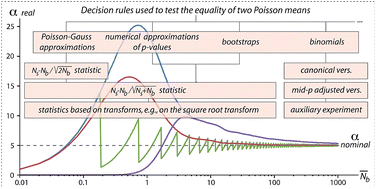Detection in LA-ICPMS: construction and performance evaluation of decision rules†
Abstract
Laser ablation inductively coupled plasma mass spectrometry (LA-ICPMS) is frequently employed for the analysis of minute isotope contents in the presence of a background noise. Distinguishing between the sample signal and the background noise at a given confidence level thus represents a routine challenge. For count numbers Nb and Ns collected during (equally long) background and sample measurements, respectively, the statistical significance of their net value, Ns − Nb, can be evaluated: how probable is it to obtain such value by subtracting two count number estimates coming from a common statistical distribution (i.e., when Ns and Nb represent measured estimates of the same mean activity)? If, based on the analysis of a model distribution of the net count numbers, we decide that this is probable, the signal is statistically indistinguishable from the background: the analysed isotope is not detected. If the corresponding (one-sided) probability is below some threshold, it is detected. The net signal value on the divide between the above alternatives, given in net counts or mass (content) units, is called critical level; optionally, it can be complemented by the computation of the detection limit; such values are often reported in the literature. Less discussed is the appropriateness of computational methods used to estimate these values. Troubles arise from attempts to apply Gaussian confidence intervals to small, discretely distributed count numbers contained in real LA-ICPMS acquisitions, and from a non-optimal estimation of the net count number standard deviation in some of the methods used for the computation of critical levels for paired measurements. Combined, these factors may result in uncontrolled, excessively high rates of false detections (background reported as detection of analyte in the sample). Here, we provide a review of methods, otherwise called decision rules, available for the critical level estimation and discuss how to evaluate the performances of these rules to enable an educated computation of LA-ICPMS detection capabilities, including the case of small count numbers.


 Please wait while we load your content...
Please wait while we load your content...